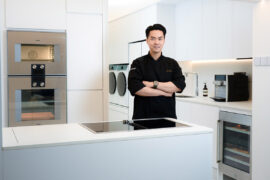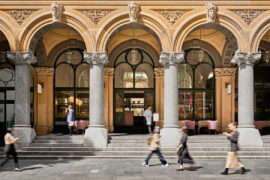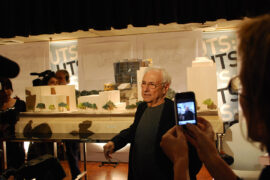With the new Tangram collection for Cesar, García Cumini introduces a timeless system of delightfully winding volumes, artfully concealed functionality and sculptural compositions that move beyond rigid angularity to redefine the social heart of the home with intuitive flow.

July 14th, 2025
From an enclosed functional space to the open heart of any home, the evolution of kitchen design has dissolved the formal boundaries of a purely utilitarian zone into a social epicentre that seamlessly melts into the surrounding living spaces, grounding the dwelling with an enveloping sense of flux. And it is precisely this emerging kitchen design language – one of freeing fluidity, discreet integration and sculptural expression – that Cesar’s new Tangram kitchen system grasps with astonishing fluency. Conceived by the visionary design duo, García Cumini, this dynamic collection of kitchen cabinets and countertops has been created to command, curve and camouflage all at once, enabling designers to sculpt kitchens into unique architectural geometries regardless of spatial limitations.

Tangram’s adaptable nature draws direct inspiration from its namesake. Much like the ancient Chinese puzzle, this simple yet revolutionary concept is composed around a core palette of five curved modules that can be combined with straight elements, unlocking an endless spectrum of design compositions that untether the kitchen from its traditional linear constraints.

Tangram’s free-flowing islands break free from overbearing rectangularity, morphing into unexpected, winding sculptural centrepieces that leverage the relationship between presence and absence to imbue the space with a sense of welcoming fluidity. The cabinetry can flow against a wall in a wave-like formation or ingeniously wrap around a corner, transforming a once-awkward space into an intentional architectural gesture – and bringing a renewed sense of possibility to more compact spaces.

To accentuate this profound sense of fluidity, the Tangram cabinet door can be detailed with Groove, a three-dimensional sequence of vertical incisions that create a subtle tactile cadence across the surface. The pattern conceals the joints between modules, which allows the entire composition to read as a single entity, while enlivening the cabinetry with a mesmerising rhythm of light and shadow. The result is a sophisticated camouflage effect, where functional elements, such as door openings, disappear into the overall form, reinforcing its cohesive, sculpted quality.

This level of thoughtful design is the hallmark of García Cumini’s design ethos. Launched in 2012, the studio is a meeting of two cultures and complementary personalities: the Spanish sensibility of Vicente García Jiménez and the Italian perspective of Cinzia Cumini. Together, they have built their practice on the concept of ‘slow design’ – a deeply considered, holistic approach that prioritises longevity, research and a genuine connection to the end-user, creating objects that artfully preserve the balance between intuitive emotion and function. Tangram, an innovative and flexible kitchen system designed for life, is a direct product of this philosophy.
However, while the collection is designed with enduring relevance in mind, its arrival is perfectly timed too – the system not only sets a new benchmark for modern kitchens but also responds flawlessly to the key currents shaping their contemporary landscape.
Just like the kitchen space, the island has evolved from a practical work surface to a sculptural statement designed to anchor the home with outstanding performance and distinctive visual vernacular. Contemporary islands have been doubling as breakfast nooks or bar areas, and designers have been reaching for striking stone palettes, asymmetric lines and organic volumes in the pursuit of this functional kitchen art – a concept fundamental to Tangram’s design.

The five curved modules provide the perfect spatial toolkit for crafting bespoke islands that move beyond rectangular convention, transforming them into winding installations that ground the space with their intuitive flow. This sculptural expression is further enhanced by Tangram’s expressive material palette of marble, engineered stone, wood and etched glass as well as integrated functionality that allows the island to double as a snack bar or dining space.
While the contemporary kitchen island is emerging as a confident design centrepiece that commands the space, the shift towards ultra-minimalism has seen appliances, storage and even sinks disappearing seamlessly into the architecture of the room. With its outstanding ability to both command and conceal, Tangram is the ultimate expression of the desire to hide away the mundane. Its continuous, curved, flowing forms – enhanced by Groove’s masterful camouflage effect – yield uncluttered planes that allow the kitchen to blend beautifully into an open-plan environment, making even the more compact interiors feel more spacious, calm and luxurious.

The austere colourways of the past have softened, shifting from stark blacks and whites to more gentle, neutral shades that foster a sense of connection to nature and harmonise with the shifting hues of natural light. These grounding, earthy tones naturally enhance Tangram’s fluid expression. Rendered in warm taupes, sand, terracotta and olive greens, the unrushed glimmers of light lazily journey across the door detailing, gently dissolving the transition between kitchen and living areas.
Beyond the earthy and soulful palettes, designers have been adding warmth and personality to the kitchens by layering traditionally juxtaposing materials. These intricate combinations – the tactile richness of timber against the cool precision of brushed steel or the opulent confidence of marble – resolve in both depth and character. Tangram’s inherent modularity – augmented by a rich material palette – encourages this shift. Whether it’s a striking composition of Groove detailing in subdued Verde Comodoro Anodic with the dramatic Breccia Imperiale Marble surface on the top or a neat juxtaposition of Noce Desaturato wooden doors with a refined etched-glass worktop, Tangram allows designers to curate pairings of different finishes and materials across its various elements to create impactful and entirely bespoke aesthetics.

In its winding forms, unexpected compositions and artfully concealed functionality, Tangram is revealed as more than a collection of cabinets and worktops – it’s an intelligent system of unbound possibility that untethers the kitchen space with an endlessly relevant architectural gesture. It trades rigid angularity for organic flow and ostentatious luxury for confidence of form, creating a fluid, intuitive and sculptural topography for the dynamics of modern life.

Cesar kitchens are available through XTRA, Singapore’s premium design destination. Visit their iconic showroom to explore how Tangram’s fluid architecture can become the defining gesture in your next project.
XTRA Singapore: 6 Raffles Boulevard #02-48 Marina Square, Singapore 039594
We think you might also like Cesar’s Dante Chester on AI integration, bespoke design and material exploration
INDESIGN is on instagram
Follow @indesignlive
A searchable and comprehensive guide for specifying leading products and their suppliers
Keep up to date with the latest and greatest from our industry BFF's!

For a closer look behind the creative process, watch this video interview with Sebastian Nash, where he explores the making of King Living’s textile range – from fibre choices to design intent.

In an industry where design intent is often diluted by value management and procurement pressures, Klaro Industrial Design positions manufacturing as a creative ally – allowing commercial interior designers to deliver unique pieces aligned to the project’s original vision.

Now cooking and entertaining from his minimalist home kitchen designed around Gaggenau’s refined performance, Chef Wu brings professional craft into a calm and well-composed setting.

At the Munarra Centre for Regional Excellence on Yorta Yorta Country in Victoria, ARM Architecture and Milliken use PrintWorks™ technology to translate First Nations narratives into a layered, community-led floorscape.

Now cooking and entertaining from his minimalist home kitchen designed around Gaggenau’s refined performance, Chef Wu brings professional craft into a calm and well-composed setting.

For those who appreciate form as much as function, Gaggenau’s latest induction innovation delivers sculpted precision and effortless flexibility, disappearing seamlessly into the surface when not in use.

Luchetti Krelle’s timeless design at Epula marries heritage grandeur with classic sophistication, celebrating the spirit of a European piazza whilst remaining unmistakably of its place.
The internet never sleeps! Here's the stuff you might have missed

We republish an article in memory of the late architect by UTS, whose Dr Chau Chak Wing Building was Gehry’s first built project in Australia. The internationally revered architect passed away on 5th December.

In the New Year, architecture will be defined by its ability to orchestrate relationships between inside and outside, public and private, humans and ecology, and data and intuition.